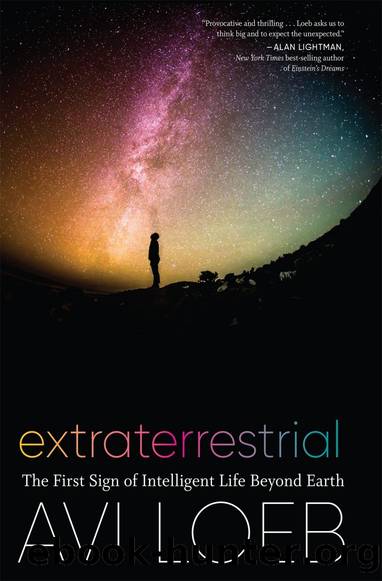Extraterrestrial: The First Sign of Intelligent Life Beyond Earth by Avi Loeb

Author:Avi Loeb [Loeb, Avi]
Language: eng
Format: epub
ISBN: 9780358274551
Google: KhbHDwAAQBAJ
Barnesnoble:
Goodreads: 54312248
Publisher: HMH Books
Published: 2021-01-26T00:00:00+00:00
Timeline of the history of the universe. The solar system formed relatively late, only 4.6 billion years ago. Modern technology appeared on Earth only over the past century, 0.0000001 billion years ago. Many civilizations could have appeared and disappeared before we developed our modern telescope technologies to detect them.
Image by Mapping Specialists, Ltd.
Working with pencil and paper, my research team modeled the idea until we reached the point where only more sophisticated computer hardware could advance it further. Volker Bromm, a graduate student at Yale at the time, took on that task, and over the past two decades he and other theorists have established that, indeed, the process we outlined for the birth of stars could give rise to the early galaxies. Models and theories are invaluable, but data that proves both remains essential. I wanted to see the gas clouds our theory predicted, which meant trying to find evidence that was about thirteen billion years old.
When astrophysicist-detectives confront the challenges of scale that the universe presents, they can become overwhelmed. They do, however, have one asset without parallel in any other academic discipline. They have the ability to look back in time.
Because light travels at a finite speed, the farther out we look, the farther back in time we see. And since the universe had similar conditions everywhere, by peering deep into space, we can view our own past.
The deeper into space we look, moreover, the older the objects we uncover. To look at a star four light-years away, such as Proxima Centauri, is to look at a star as it was four years ago. But if we focus our telescopes on a galaxy that was thirteen billion light-years away when its light was emitted, we are glimpsing the universe as it was thirteen billion years ago. To peer that far back into the âdark agesâ of the universe, the moment when the clouds of gas from which the first stars arose gathered, is a monumental scientific challenge. It also forces us to contemplate the incomprehensibly vast timescales of the universe. Humans today live, on average, nearly seventy-three years. To have seen the first lights in the universe come on thirteen billion years ago, we would have had to live almost one hundred and eighty million lifetimesâan idea that is especially absurd considering that the Earth is only about 4.5 billion years old and that we believe the planet has supported life for only 3.8 billion of those years.
Looking into the universe, astrophysicists also come face to face with the physical immensity of the cosmos. We can see light that was emitted earlier in cosmic history. The universe resembles an archaeological dig centered on us. The deeper we look, the more ancient are the layers we uncover. This exhibit of cosmic history continues all the way back to the edge of the visible sphere around us, located at the Big Bang, 13.8 billion years of light travel time. It takes light originating beyond this edge more than the age of the universe to reach us, and so more distant regions are not visible to us.
Download
This site does not store any files on its server. We only index and link to content provided by other sites. Please contact the content providers to delete copyright contents if any and email us, we'll remove relevant links or contents immediately.
| Automotive | Engineering |
| Transportation |
Whiskies Galore by Ian Buxton(41716)
Introduction to Aircraft Design (Cambridge Aerospace Series) by John P. Fielding(33014)
Small Unmanned Fixed-wing Aircraft Design by Andrew J. Keane Andras Sobester James P. Scanlan & András Sóbester & James P. Scanlan(32682)
Craft Beer for the Homebrewer by Michael Agnew(18079)
Turbulence by E. J. Noyes(7891)
The Complete Stick Figure Physics Tutorials by Allen Sarah(7261)
Kaplan MCAT General Chemistry Review by Kaplan(6818)
The Thirst by Nesbo Jo(6751)
Bad Blood by John Carreyrou(6471)
Modelling of Convective Heat and Mass Transfer in Rotating Flows by Igor V. Shevchuk(6352)
Learning SQL by Alan Beaulieu(6156)
Weapons of Math Destruction by Cathy O'Neil(6080)
Man-made Catastrophes and Risk Information Concealment by Dmitry Chernov & Didier Sornette(5873)
Digital Minimalism by Cal Newport;(5579)
Life 3.0: Being Human in the Age of Artificial Intelligence by Tegmark Max(5402)
iGen by Jean M. Twenge(5320)
Secrets of Antigravity Propulsion: Tesla, UFOs, and Classified Aerospace Technology by Ph.D. Paul A. Laviolette(5234)
Design of Trajectory Optimization Approach for Space Maneuver Vehicle Skip Entry Problems by Runqi Chai & Al Savvaris & Antonios Tsourdos & Senchun Chai(4951)
Electronic Devices & Circuits by Jacob Millman & Christos C. Halkias(4861)
